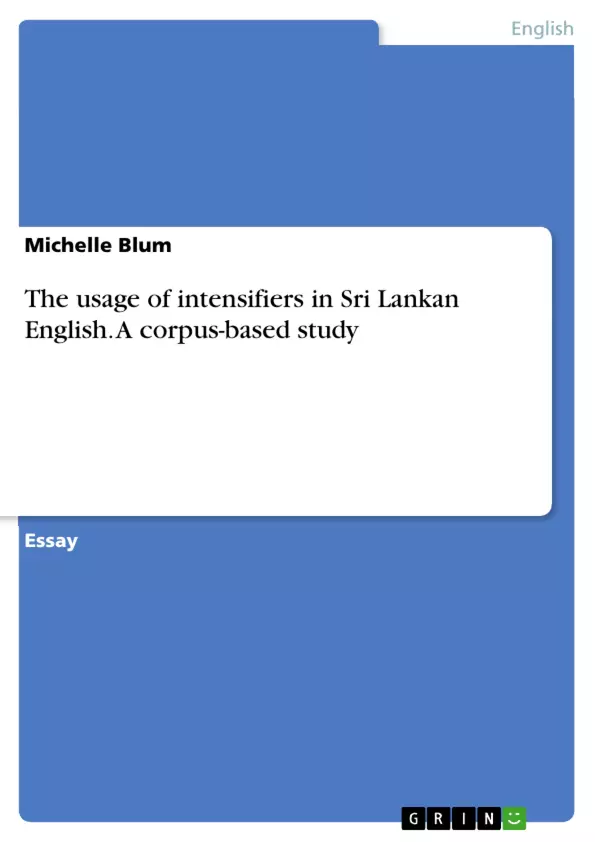Intensifiers - very small words, but with a very strong impact on language use. In fact, it could be argued that they are so important to study due to their ever-changing nature. Murphy, in 2010, even stated that "the most rapid and the most interesting semantic developments in linguistic change are said to occur with intensifiers." But why are intensifiers used? According to Hu, in 2013, they arise out of "a speaker or writer’s desire to be “original” to demonstrate verbal skills, and to capture the attention of an audience". An even more intriguing part of intensifiers is that this does not seem to work at times. According to Wright, in 1995, "the most interesting finding about intensifiers is that they do not seem to affect listeners in the way intended by speakers". Wright argued that advertisements, for instance, worked less well when an intensifier was added, since they seemed to influence the viewer in a negative way and seemed to take away from the product. However, while researchers disagree on the exact reasons to research intensifiers, be they investigating a speaker’s wish for originality, language change, or the fact that intensifiers do, at times, negatively impact the recipient of the intensification, the fact still stands that they are worth investigating.
Sri Lanka is a comparatively small island state south of India. It only recently, in 2009, finally escaped the clutches of colonialism and civil war. Today, it comes into its own more and more, and is finally able to rewrite history on its own terms. Sri Lankan English is a fresh, new research ground that offers a variety of opportunities for the advancement of learning.
Inhaltsverzeichnis (Table of Contents)
- 1. Introduction
- 2. Theory
- 2.1 Sri Lanka
- 2.2 Sri Lankan English
- 2.3 Intensifiers
- 2.4 Research questions
- 2.5 Hypotheses
- 3. Methodology, Data
- 4. Results
- 5. Discussion of Results
- 5.1 Answering the research questions
- 5.2 Revisiting the hypotheses
- 5.3 Future outlook
- 6. Conclusion
- 7. References
Zielsetzung und Themenschwerpunkte (Objectives and Key Themes)
This study investigates the usage of intensifiers in Sri Lankan English, aiming to explore their role and frequency within this specific variety of English. The study utilizes a corpus-based approach to analyze the data and draw conclusions about the prevalence and function of intensifiers in Sri Lankan English.
- The influence of colonialism and language contact on Sri Lankan English
- The use of intensifiers as a linguistic feature in Sri Lankan English
- The role of intensifiers in conveying meaning and pragmatic function
- The impact of intensifiers on listener perception and communication
- The potential for future research on intensifiers in Sri Lankan English
Zusammenfassung der Kapitel (Chapter Summaries)
- Chapter 1: Introduction This chapter introduces the study's topic and provides background information on intensifiers, highlighting their importance and potential impact on language. The chapter also introduces the research context of Sri Lanka and Sri Lankan English.
- Chapter 2: Theory This chapter presents a theoretical framework for the study, providing detailed information on Sri Lanka, Sri Lankan English, and intensifiers. The chapter also outlines the research questions and hypotheses that will be explored.
- Chapter 3: Methodology, Data This chapter details the methodology and data used in the study, providing insights into the specific corpus and analytical methods employed.
- Chapter 4: Results This chapter presents the results of the study, focusing on the findings related to the prevalence and usage of intensifiers in Sri Lankan English.
- Chapter 5: Discussion of Results This chapter discusses the results in greater detail, analyzing the findings in relation to the research questions and hypotheses. It also explores potential future research directions related to intensifiers in Sri Lankan English.
Schlüsselwörter (Keywords)
The study's primary focus is on the usage of intensifiers in Sri Lankan English, utilizing corpus linguistics as a methodology. Key terms and concepts include Sri Lankan English, intensifiers, amplifiers, downtoners, corpus-based analysis, pragmatic function, language contact, colonialism, and sociolinguistic factors.
- Arbeit zitieren
- Michelle Blum (Autor:in), 2019, The usage of intensifiers in Sri Lankan English. A corpus-based study, München, GRIN Verlag, https://www.grin.com/document/1128280



